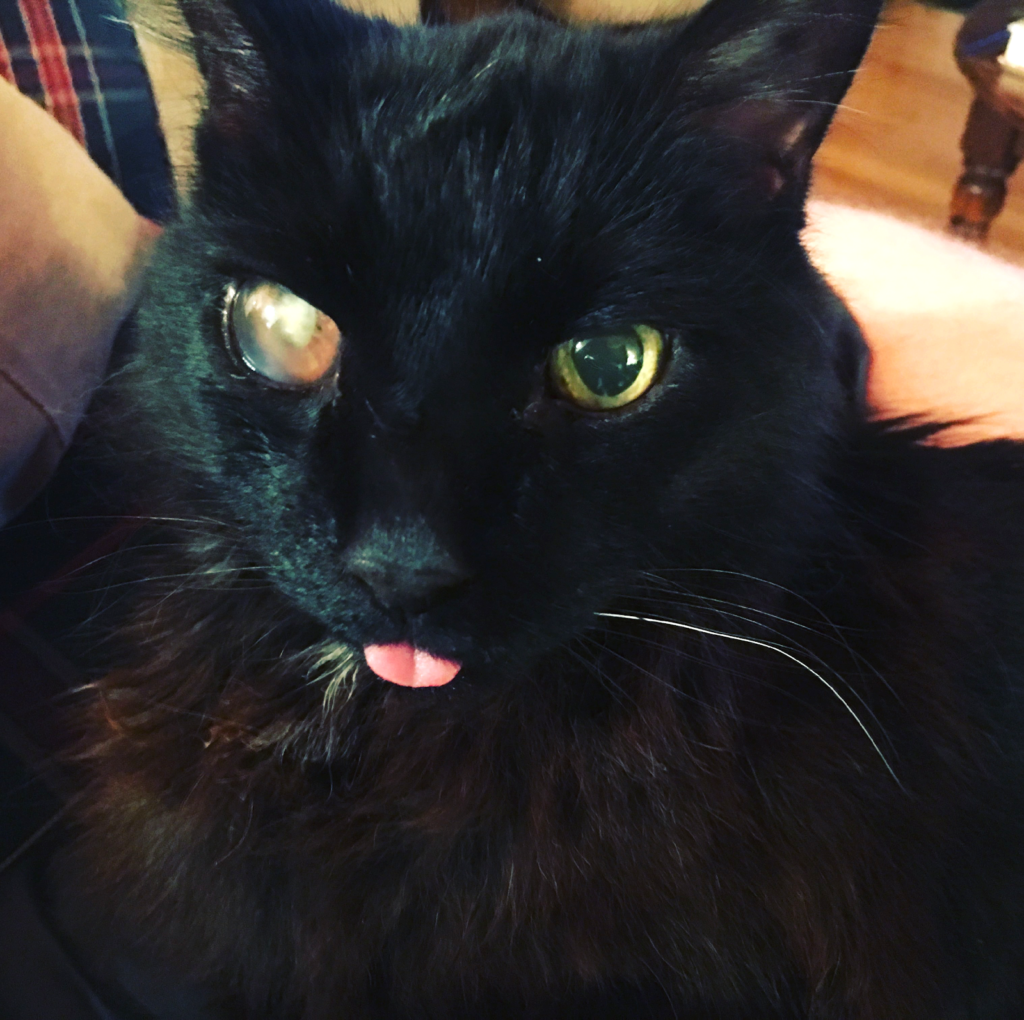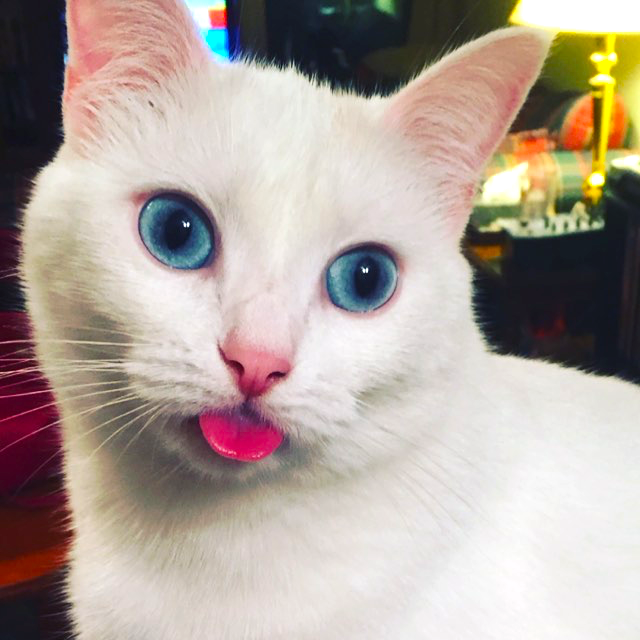Since 2008, I’ve owned a one-eyed cat, known officially as Spriggan, but also yclept Oracle-Eye or Odin due to his one full-white eye. Last week, he went full Tiresias—both eyes milked over and sightless. The vet isn’t sure why. Once you hit fourteen or fifteen, they stop caring so much about health and start prioritizing comfort. So he bumps into walls if he gets overexcited, and he shits on the hardwood if he gets confused, and he gets all the treats and hand-fed scraps he wants. Here, then, is the oracle himself:

Meanwhile, his two-year-old housemate, Zissou, hunts him mercilessly and guilelessly. For comparison, here’s the Ziss:

(Yes, he’s the Game Day version of Adorned Pouncer.)
This is a fun introduction to write, but there’s, as ever, something deeper going on here. Manichean philosophy is dreck, but I do see something humorous in the contrast between the snow-white and beautiful hellion and the grease-slick lurkduke with the sweetest temperament. More to the point, there’s something mystical about Sprig, as he gazes off into the distance—something otherworldly. I know his spooky detachment is because he can’t see and has an IQ of “null,” but there’s a damaged nobility in the way he perches.
Much has been made of Egyptian cat worship, of cats as psychopomps and ethereal beings, and so much of it stems from the fact that you live with something—you build trust and round each other’s edges—with which you can never communicate. You offer yourself up to an alien intelligence—and you may have opened yourself up to more than you thought you did at the time you adopted that six-ounce fuzzball.
Per the CDC, your chances of being currently infected with toxoplasmosis gondii (assuming you’re reading this in America) are about 1 in 9. Toxoplasmosis encysts in the brain—basically, your immune system isolates and condenses the microscopic toxoplasmosis cells—and can lie dormant for decades. There are some suggestions in the medical community, mostly derived from the studies of a Czech scientist, that these cysts can cause behavioral abnormalities in people infected with the parasite, but the science isn’t fully in just yet. If that’s the case, though, the outcome here would be that the toxoplasmosis parasite drives its host to take more risks in order to propagate through the soil or through skin-to-skin contact, similar to the erratic behavior triggered by late-stage rabies. In addition, it might cause inexplicable personality changes and the continued attraction to host animals that carry the parasite (indeed, rats infected with toxoplasmosis are drawn to cat urine). Personally, this would go a long way to explain the mid-oughts obsession with cat macros and the current adoption of catlebrities, so I think they may be onto something here.
As a disease, toxoplasmosis isn’t a huge deal in adults—at the worst, it tends to cause some mild flu-like symptoms upon infection before going dormant in the brain—but it can cause severe birth defects, brain damage, or death in gestating fetuses. Meanwhile, the effects of toxo on non-human species is huge—coastal communities can, through improper disposal of cat feces, help wash the parasite into waterways and infect shellfish and fish. A 2005 study calculated that 72% of otters in California were infected with the parasite—in otters, the disease will often be fatal.
There’s another disease that cats unintentionally helped spread—one of the big ones, in fact: the bubonic plague—also known, of course, as the Black Death. There’s a common, albeit potentially apocryphal, story about the outbreak of the plague and how people slaughtered domesticated cats by the score, frightened of their association with the netherworld and the occult. The Yersinia pestis bacteria is carried by fleas that are endemic to rats and other rodents—i.e., cat-food. So the same cats that could have decimated the rat population, decreasing human exposure to the bubonic plague, were the ones they killed off the bat.
Even seven hundred years later, there still remains a kind of culture-wide trauma related to the Black Death in Western media—it makes sense, considering the disease killed between twenty-five and forty percent of the European population in a single decade. Narratively speaking, plagues are passive. They have no regard for motivation or for importance. They reap universally, dictated by luck and immunity, without regard for human structures. The danger of diseases in fiction (c.f. Neal Stephenson’s writing about the Great Plague in the 17th century in Quicksilver) is that either your character lives or dies by the provenance of the author. Disease is either an inert force or an atrocity.
Magic has feinted towards massive outbreaks before—the unfreezing of Krov during the Melt resulted in plagues that annihilated the population of the city—but there’s a very simple reason why we haven’t seen a block set in a world beset by a plane-wide disease: Magic is a game. Games are meant to be fun, and watching most everyone you know die in grueling ways is the complete antithesis of fun. Very few of Magic’s planar civilizations are technologically advanced enough to invent immunization, which is odd. Indeed, one of the few successful immunizations was Yawgmoth’s inoculation of the Thran (although his serum was basically magical chemotherapy, rather than a vaccination), and we know how that turned out.
He applied that same technology thousands of years later. During the Phyrexian Invasion of Dominaria, the aggressor used engineered plagues (Engineered Plague) as shock warfare (Vile Consumption), dropping genetically-goosed diseases (Spreading Plague) on highly-populated areas to depress resistance. That was depicted—rightly and uniformly—as a monstrous act, but there’s a nebulous zone between “minor references to plagues” and “chemical warfare.” Phyrexia spreads like a plague, through self-replicating actors that spread through contact, and so it makes sense that it would capitalize on the weakness of flesh and the vagaries of immunity on the battlefield.
So we get minor references without context. What plague, exactly, is Amonkhet’s Plague Belcher belching? What makes Virulent Plague so effective in a world of dragons? And so we have an incomplete and ahistoric depiction of disease.
In terms of gameplay, disease generally takes the form of a temporary or permanent reduction in stats—see Plague Dogs, Shambling Swarm, Traveling Plague, etc.—or outright destroying (Spreading Plague). I like that dichotomy, honestly—sometimes an illness knocks you out for a couple of days before you bounce back, and sometimes it lingers. Sometimes it becomes part of who you are; it becomes the new normal.
Speaking of: as I write this, Spriggan is in his usual place—wadded up on my lap, alternately purring and grumbling as I shift positions. He’s resting with his eyes open; there’s no longer any need to block out light from his sensitive pupils. He can’t catch tree-rats anymore; he can’t bring me headless squirrels or the rumpled corpses of birds. He gobbles food and then, system weakened, vomits in corners. Secret parasites coil and breed within him. Indoors-only now, I have to clean out his litterbox twice a day, doubling my chances of being exposed to toxoplasmosis gondii. Still, when I settle in for some Netflix or reading, he’s a constant, chum-scented presence, creakily hopping up on the couch to settle onto me, engaging in that curiously polymeric spread that cats do.
Alright, this was a long and vaguely tragic article. You’ve earned one last Zissou:

Next time: We take the next step and talk about bereavement and the grieving process.
A lifelong resident of the Carolinas and a graduate of the University of North Carolina, Rob has played Magic since he picked a Darkling Stalker up off the soccer field at summer camp. He works for nonprofits as an educational strategies developer and, in his off-hours, enjoys writing fiction, playing games, and exploring new beers.

